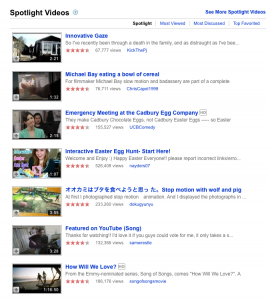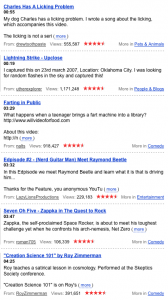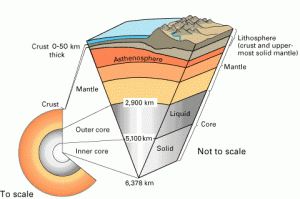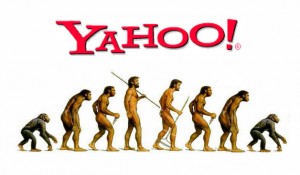There’s been a fascinating and widespread reaction to YouTube’s redesign, which was based somewhat on superficial changes to YouTube’s homepage (phase one referenced in YouTube’s blog, and a broader change is planned per NewTeeVee and ClickZ).
But the fate of YouTube’s partners, professionals and user-generated content is driven less by the homepage than the “secret sauce.” What, you ask, is “the secret sauce”? Hang with me for a moment first. I promise we’ll get there, and I’ll even give you tips for giving yourself a competitive advantage.
In this horrifically long post, I’m going to analyze the homepage, show why most reactions are missing the point, explore how a video gets “love” on YouTube, and give you some tips for getting views.
Since the redesign, we’re seeing the homepage’s vitality wane. Those homepage videos fetch fewer views than they once did. Where a featured (now “spotlighted” video) once got 100,000 to 500,000 views, the YouTube homepage is less of a driver than before. In case you missed the memo, here’s the latest vernacular.
- Spotlight Videos: Highlighted videos YouTube thinks you’ll want to watch, and a “thematic” approach to showcasing the best of the community and partners.
- Promoted Videos: Those driven by advertising.
- Featured: Includes YouTube’s partner content, other popular content, or those previously spotlighted.
Compare these two screen shots as exhibit A & B: The first is a shot of today’s “Spotlight” videos (aka featured), and the view counts are perhaps 200K on average.

Now see YouTube (via archive.org) about 2 years ago when “Farting in Public” was on it. This is not a scientific study, but you’ll see higher average numbers despite the fact that YouTube’s traffic today is exponentially higher than it was one or two years ago. We’d expect to see today’s YouTube homepage videos commanding views that are exponentially higher. So what gives?

The coveted YouTube homepage is still prime Internet real estate, of course, and the slippage of average homepage views isn’t entirely driven to the recent redesign — because this phenomenon is not new. A year ago I spoke with an interactive director of a popular company that had its video ad featured on the 2006 homepage, then again in 2007. Before asking him about his results, I told him I imagined far fewer people watched his most recent homepage-featured ad. He asked how I knew, and I explained that we regular YouTubers had grown immune to the large ad on the homepage.
Alas, the power of the YouTube homepage has become, and will continue to become, less important in influence, at least relative to other secret tools at the disposal of The Commercializers of YouTube. Why?
- First, only a small portion of daily YouTube visitors even actually see the homepage. They dive deep into YouTube for a specific video, and then out.
- Regular visitors (those who spend 20-60 minutes per day on the site) have largely customized their experience to give primacy to their favorite creators via “subscriptions.”
- That leaves only the people inclined to visit a homepage of any site, or those that are new and eager to explore. This is a minority, and the longer we spend on YouTube the less we care about the homepage.
YouTube, now behaving more as a division of Google than a standalone UGC/video sharing site, will continue to reward content based on two factors: relevance to viewers, and the premium of the ads they generate. Google prides itself on a legacy of innovation that is often instinctive and not customer driven — we didn’t know we needed Google search in a crowded market. And we didn’t know we needed Gmail, which has more traffic now than YouTube itself.
But most of us miss this fact. Let’s look at some comments about the redesign (from blogs/discussion groups, especially NewTeeVee and ClickZ). They’re focused mostly on the homepage and organizational principle, but are overlooking the more powerful dynamics driven by YouTube’s “secret sauce.”
- They’ve been disenfranchising us more and more. Eventually we’ll migrate elsewhere and youtube won’t have an audience to advertise too.
- I think the trend is going towards compartmentalizing video content 1. Quality + Professional free with the hassle of advertising 2. Mixed Quality + free between terrible and good UCG that can be found on sites like youtube and howcast with the hassle of advertising 3. Paid entertainment, video content that can be purchased through itunes 4. Paid, quality instructional content that can be purchased
- I reckon that for four tabs.: Music-25% , Films-10% , TV-15% , UGC-50%
- In effect, they are garden walling all the UGC on YT into a section so that if you want to ignore it you can.
- I go to youtube because I *like* seeing good UGC (gasp)! I totally get that advertisers worry about what stupid crap their ads show up next to, but if youtube can’t patrol their homepage – why can’t they let their trusted users do it
- I feel this change will marginalize UCG content, but it’s still a million times more democratic than the TV model.
- The creation of a premium “sand box” for professional content will allow independent producers and large media companies to showcase and monetize their content more efficiently. Also, all content producers on the site will benefit from the inevitable increase in ad spends that are pushed to Youtube.
- Hilarious! “Premium content” is just what the many millions of YouTube watchers don’t want!
- I think this will give websites like Viddler and Vimeo a chance to grow their communities to the height of YouTube’s current level of success.
- The UGC community on YouTube can succeed if they are able to monetize more easily and if established and rising “stars” are identified and receive promotion that positions them as “must-watch,” “YouTube only” content. They can be seen as complementary, and the more YouTube facilitates a parity the better.
Well you’ve made it this far, so it’s time to reveal “The Secret Sauce” of Google/YouTube. As I said, video content will rise/fall based on consumer relevance (duration of view, relevance by keyword, ratings, view counts, favorites, etc.), but the most vital aspect is “black box,” or confidential. We can deduce some things using “Google search” as a proxy. Google’s search results rewards advertisers who bid high prices for “paid placement,” and organic (natural) results based on whether the content is “relevant” (as defined by inbound links and whether we engage, or return Google to refine the search).
Not surprisingly, YouTube is replicating that Google model — giving “love” to content that either satisfied viewers and/or can be monetized via the Partners program. Unfortunately, YouTube is less transparent about whether a video receives primacy because of relevance or ad dollars. There isn’t a clear visual divide between paid and organic videos, even though the new labels (spotlight, promoted, featured) are a step in that direction, and this will continue to become more clear to even the naive surfer that still can’t distinguish between an ad or organic result on Google.
To consider how a video fails or thrives, consider the experience of a typical viewer navigating YouTube. They may choose to engage in the following ways:
- Visit a specific video based on a link/forward from a friend. They may hang around, or dash.
- “Hang out” with the community — and that segment continues to grow, but represents a smaller share of overall traffic. It’s also less important from a commercial standpount.
- “Browse” related videos, and passively accept the “related content” YouTube serves after a video.
- Dive into a favorite creator (and subscribe)- that could be a pro or an amateur.
- More and more, visitors search for what they want — whether it’s the latest video gossip about a news figure, or “how to play a jawharp.”
- Few, I believe, use the homepage design to delve into specific segments or such areas as “most watched” of the day, week or month. It’s possible that YouTube’s user interface (tabs, categories) can be important, but less so than most think.
THE SECRET SAUCE
The “secret sauce” is Google’s proprietary scheme for keeping the viewer engaged, and ensuring that the content continues to not just satisfy their curiousity, but more importantly “hook” them for more viewing (and it works based on average views consumed by a YouTuber relative to a Yahoo Video viewer). The “secret sauce” is, and will always remain, highly confidential and in flux. Otherwise we’ll “game the system” through various tricks. The algorythm that makes up that sauce will get smarter, and more difficult to fool.
We can complain about the “secret sauce,” or accept it and evolve. That means our video content needs to be relevant and captivating. Partners have a distinct advantage, because YouTube would be foolish to favor videos it can’t monetize. So we’ll see powerful and deep-pocketed commercial networks/producers (and advertisers) get an increasing “leg up” on amatuers by giving YouTube a financial incentive to show their videos “love” through paid buys, and favored placement. These entities can pay for “love,” or YouTube may give them free “love” to hook new audiences and mutually monetize their content long term. Recall how much premium placement PopTub had for a while. And sometimes an amateur gets lucky because their content gets “stuck” on the homepage (we saw that last month with CommunityChannel and a few others).
In the meantime, here are some basic tips, and some haven’t changed since last year when I wrote my free eBook (“How to Become Popular on YouTube Without Any Talent“).
- Create videos about content that is topical and searched. That’s how Buckley and Sxephil attracted a following that is now somewhat self sustaining.
- Build a distinct niche, and market your videos via like-creators and via properties (blogs) beyond YouTube.
- Continue to reply to videos that are already popular. The viewer will see the thumbnail, and your video will pick up “spillover.”
- Ensure the videos are tagged appropriately, but are also compelling, and engage the viewer. Otherwise algorythms will mistake those for spam. It doesn’t work anymore to tag your video with “sex” and expect that video to sail.
- Those thumbnails are as vital as ever. If a video is promoted, featured or spotlighted, the viewer will decide to engage based on the title, thumbnail and duration (we still want short videos).
- Here’s a doozy: Leave blank space after your video, so your viewers are less likely to “escape” via “related videos” served involuntarily by YouTube after the video plays (you want your viewer instead choosing a thumbnail for your own video, and those appear beneath the video).
- Finally, you’d better monetize your videos and become a YouTube Partner. Sponsored videos that aren’t monetized are not likely to thrive as well as entertaining videos that earn Google and its partners ad dollars.
It’s indeed harder to become an “overnight” success, especially when we have a “vicious cycle of fame”: it takes lots of views to qualify as a partner, and partner status to get more views. So the rich may get richer, and the bar is rising. But don’t despair! JeepersMedia is surpassing 100,000 subscribers, and had only had 4,300 subscribers 10 months ago. So there’s still room for new video creators who tap distinct audience niches, and manage (like Jeepers) to rank continually among the most highly-rated videos of the day.
And as long as the “subscription” model remains important to new YouTube addicts, your success breeds success. A good video can prompt a YouTube noob to subscribe (especially if you ask them to), and then your chances of that individual watching your future videos are much higher.







